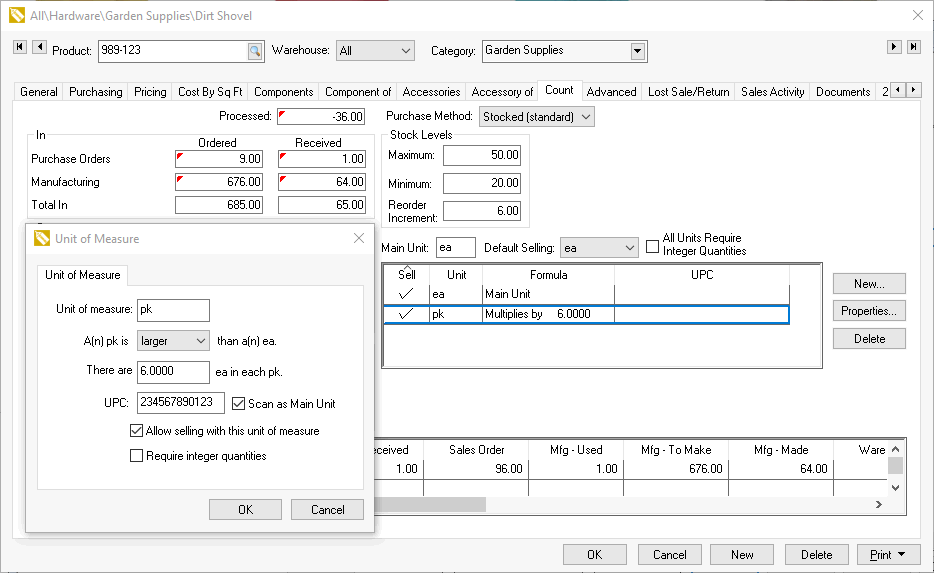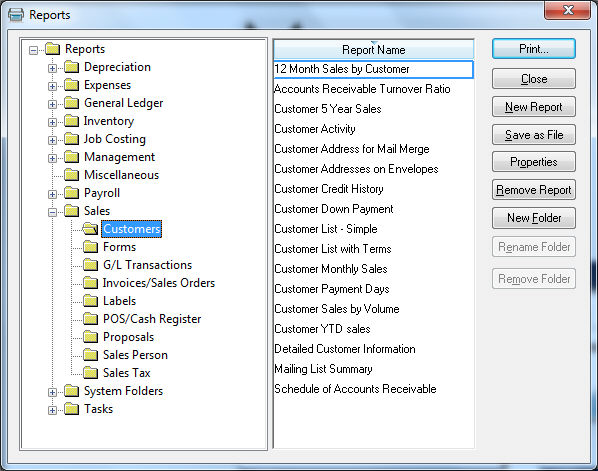Entering Barcodes
Review Scanning Barcodes for instruction
son how to use barcodes scanners and EBMS.
barcodes can be associated within individual inventory items using the
following methods:
Enter the product's UPC code manually
Copy the UPC code from a vendor catalog which is the most efficient
Scan the UPC code with the product information in a vendor catalog
to add by scanning
Print the Product ID
using the BAR 39 barcode
Associate the barcode to the inventory code using a mobile scanner
Each option is described in the section below.
Enter the product's UPC code
A barcode such as a UPC
code can be entered within the inventory item record. Open an
inventory item and click on the General
tab.
Enter the UPC or
Alternate ID as shown above. This barcode identifies
the Default Selling unit of
measure recorded within the Count
tab.
The barcode values for other units of measure are
set within the UOM dialog. Click on the Count
tab, select a unit-of-measure form the list, and click the Properties
button to open the following dialog:
Enter the specific Unit
of measure barcode within the UPC
entry and press OK to save.
Review Printing Barcodes
for options to include the Unit of Measure into the barcode.
Enable the Scan as
Main Unit to always use insert the main unit of measure
within the sales or purchase document.
Copy the UPC code from a vendor catalog
This option is the most efficient way to associate a barcodes to a large
product catalog. Associate the UPC barcodes within the product
catalog with the UPC codes within the vendor catalog. Review Vendor
Catalog > Creating Relationship with EBMS Product Catalog to configure
the vendor catalog to copy the barcode into the UPC
or Alternate ID entry.
All new product items added to EBMS will contain the UPC
or Alternate ID since the new item is created and updated from
the vendor catalog. Review Vendor
Catalog > Creating Inventory Items from a Vendor Catalog for instructions
to add new products to a sales invoice or proposal.
Scan the UPC code with the product information in a vendor catalog
EBMS can be configured to associate the barcode to an existing item
using scanners. For example, product can be scanned during
the receiving process even if the product does not have a populated UPC or Alternate ID setting if the
following configuration is completed.
Associate a vendor catalog that contains the UPC code
and product information for the items that is being scanned:
Create a relationship between the UPC code within the vendor
catalog and the UPC or Alternate
ID code in the EBMS product catalog. Review Vendor
Catalog > Creating Relationship with EBMS Product Catalog to
associate the barcode within the vendor catalog to the UPC
or Alternate ID entry.
Open a purchase order that contains product that requires a
barcode and has an associated vendor catalog with the barcodes. Review
Scanning Barcodes for additional
instructions.
Print the Product ID using the BAR 39 barcode
This method gives the user the ability to create a barcode using the
Product ID instead of using the
manufacturers barcode.

Complete the following steps to print BAR 39 barcodes:
Validate the Item code:
Unlike the UPC code, the barcode 39 can consist of numbers or
letters and can be of varying lengths. Note that the longer the inventory
item ID the longer the barcode.
Verify that the product Item
code does not include spaces or invalid symbols. Most
symbols do not properly convert into barcodes. Accepted symbols are
asterisk (*), dash (-), plus (+), and slash (/).Note that IDs that
contain spaces can not be scanned using the barcode 39 font.
The EBMS system contains many reports that contain barcode fonts.
Enable the Print barcode option
on the print dialog of the report if the optional EBMS barcode font
option is installed. Note that there are many barcode labels included
in the reports menu. Go to FIle >
Reports dialog for a complete list of reports.

Associate the barcode to the inventory code using a mobile scanner
Review Mobile Scanner > Inventory for
instructions to use a mobile scanner to associate the UPC code to an inventory
item.
Review Mobile Scanner > Overview
for instructions to use the mobile scanner.



